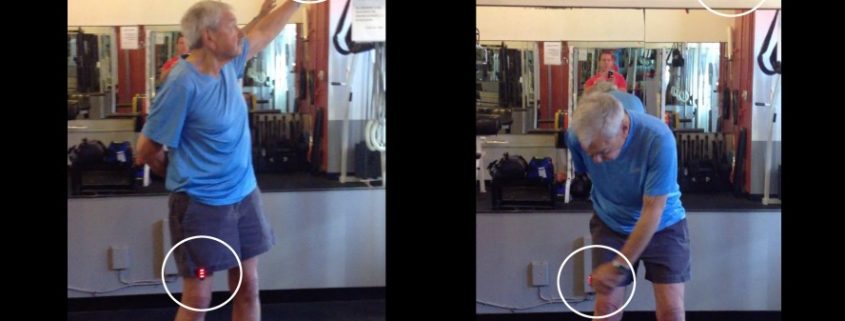
By Patrick LoSasso, Strength & Conditioning Specialist, Trainer, CSCS,*D.
How Parkinson’s exercises can bring balance and strength to your life through appropriate movement.
The prospect of beginning a Parkinson’s exercise program can seem daunting. So what do we do? We postpone it. We make excuses to avoid it, or simply say, “I’m going to start first thing next month.” As a trainer, I’ve heard it all. My favorite is, “I have to start working out, but I want to get in shape first.”
Recognized Importance
But exercise is key for those with Parkinson’s – with new studies giving support. The University of Pittsburgh Department of Neurology, writing about Michael J. Zigmond, PhD., and his team of researchers:
They further believe that endogenous trophic factor expression can be enhanced by exercise which in turn can be neuroprotective. And they have evidence that protection also can derive from acute exposure to low levels of a neurotoxin, a form of preconditioning.
© 2012 Department of Neurology, University of Pittsburgh.
Dealing With Obstacles
I’ve noticed that one of the biggest obstacles preventing us from making fitness a priority in our lives is the feelings and fears the words “workout” or “exercise” conjure from commercials, billboards and infomercials.
These words often induce images of that poor miserable individual drenched in sweat, running on the treadmill, laboring on a bike, or lifting heavy weights for hours on end. The truth is, high intensity exercise is great but the other and more important truth is that even the brief 5-15 minute session of easy, controlled, “therapeutic movement” can bring about significant improvements in your health and function.
Additionally, these brief sessions, if scheduled and adhered to, create a behavior pattern which often leads to more lengthy and vigorous exercise. The benefits of exercise or therapeutic movement are many. Research has shown that exercise can not only cause improvements in function, it also delivers a level of neuro protection to important brain cells.1.
What works
I’m often asked what types of exercise are good for Parkinson’s. First, you should choose a method of exercise you enjoy. It should be one that incorporates safe, low impact, systematic and repeated movement patterns, and one that tasks your body to an exertion level a bit above to which it is accustomed.
It should be one that delivers functional carry-over improvements to your activities of daily living that you notice. A brisk and steady 5-15 minute walk is a great way to start. Biking, walking, and the elliptical (with arm movement), are a few of my favorite cardio exercises for individuals with PD.
There are also many different movement routines you can perform from the chair or standing that don’t involve lifting heavy weights that can improve your posture, strength, balance, and range of motion. I will present a series of movements at the Step by Step Walk/Run event on April 12th that will help get you going.
Progress
What many don’t realize is that you can get stronger without actually building more muscle. The following may seem a bit technical, but we all have muscle fibers throughout our body that aren’t helping us because the nerves or motor units that are responsible for their muscle fibers activation are dormant or aren’t “turning on.” Imagine your hand is a motor unit (nerve), and at the end of each finger is a muscle fiber. If that “hand” or motor unit doesn’t activate, none of those associated muscle fibers contract.
Thus, if we can encourage or coax that “hand” or motor unit to begin participating again, all of the muscle fibers associated with that motor unit contract with full force! It’s called the All or None Principal 2. and it delivers an immediate increase in strength. Isn’t that wonderful?
The first day we begin an appropriate therapeutic movement program we begin to activate and recruit these muscle fibers. More activating muscle fibers means more strength, and we haven’t even built new muscle! Additionally, these fibers now have the potential experience hypertrophy. They become bigger and stronger with use going forward. Not because we performed a 50 minute strength training workout, simply because we began a 15 minute therapeutic movement program!
Parkinson’s Association Step by Step Walk/Run
On April 12th at our Parkinson’s Association Step by Step Walk/Run I will present a series of simple, easy to perform movements designed to get you started. For those of you are currently exercising, great! I know you will find these strategies useful. For those that are discouraged by the prospect of a “workout” or beginning to “exercise,” I hope that my talk will provide you with the motivation you need to get moving to a place of strength and balance.
You just need to start! You can begin with as little as 5-15 minutes a day, 3-5 times a week. You will see improvements. Of course, the harder you work, the more substantial your gains will be.
Why not start a simple movement/exercise program this week so that on April 12th you can raise your hand high and say “I’m moving now!” Start a scheduled walking routine. You can also download my free eBook at PatrickLoSasso.com. It has some great information and includes exercises and stretches that will help get you started.
As I like to say, I’ve seen small changes make big differences. So get proactive and empower yourself. You can make things better. You can fight back and have fun doing it!
Email me your exercise questions at Patrick@PatrickLoSasso.com
Patrick LoSasso Demonstrating Rejuvenating Exercise and Therapeutic Movement for Parkinson’s .
1. University of Pittsburgh, Dr. Zigmond et al.
2. Henry Pickering Bowditch in 1871 for the contraction of heart muscle





